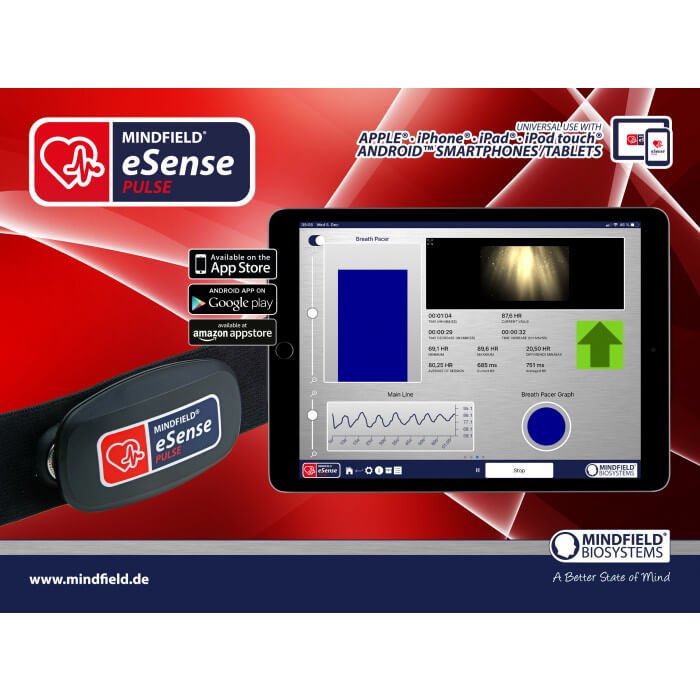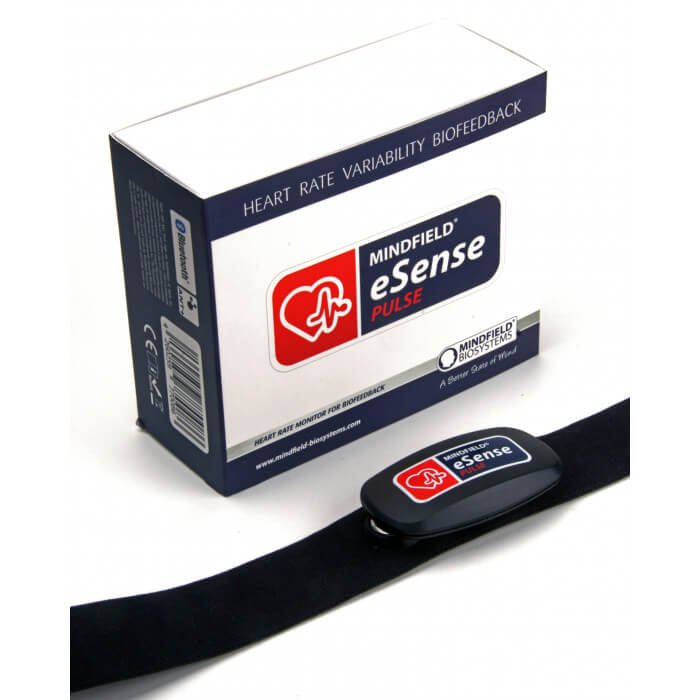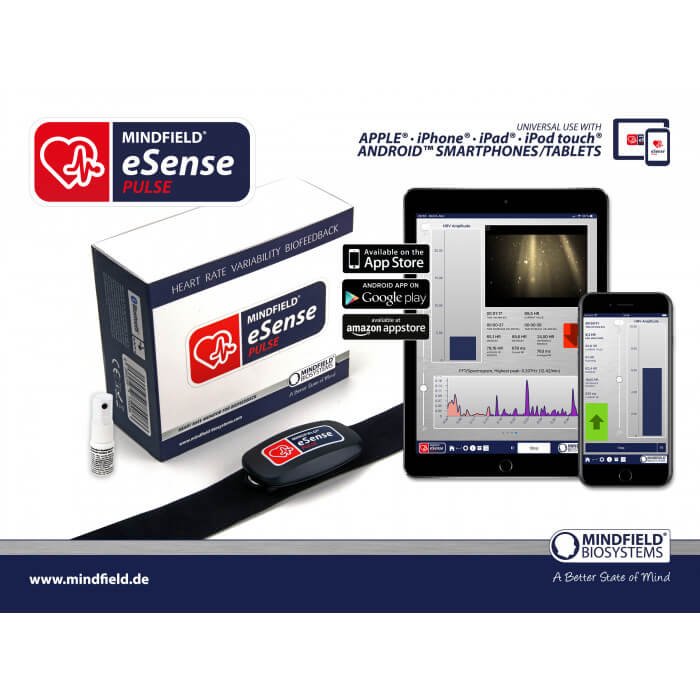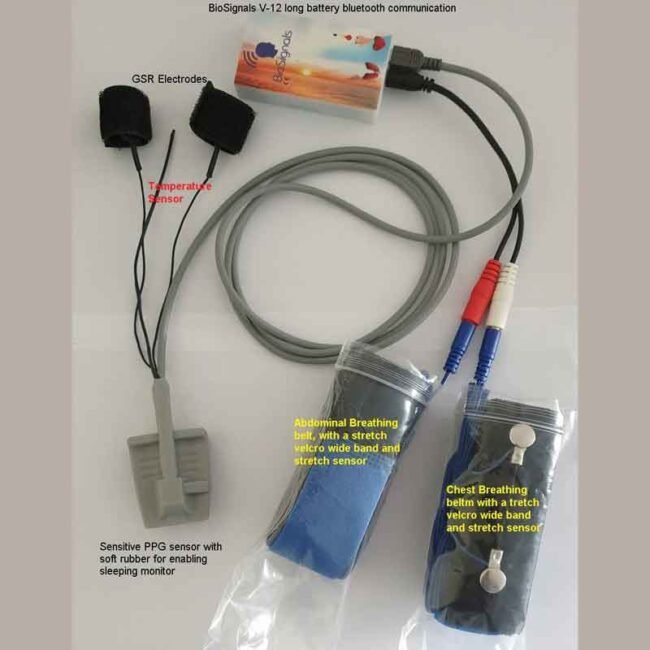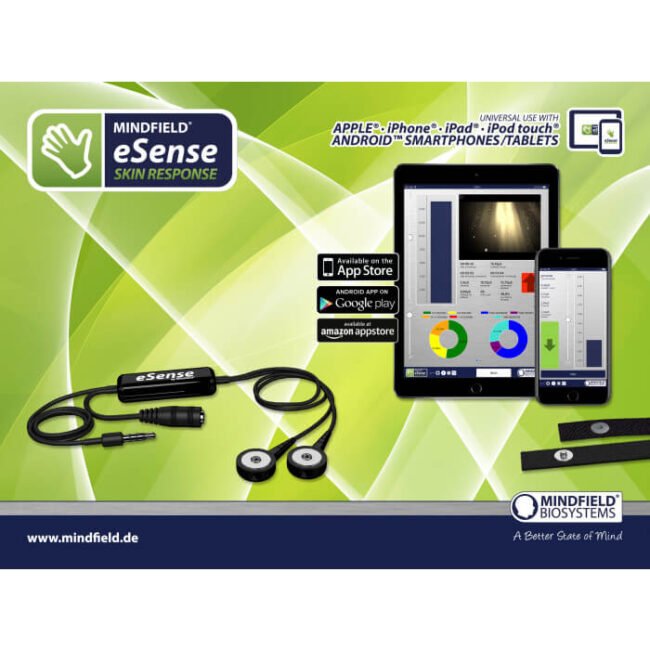Description
The Mindfield eSense Pulse HRV Biofeedback device for home use is a handy sensor for measuring the heartbeat (heart rate variability) via Bluetooth of a smartphone or tablet (Android and Apple iOS).
It will help you to reveal and manage:
- stress and its consequences,
- anxiety,
- depression,
- heart disease and hypertonia,
- insomnia,
- emotional instability,
- it can be used in coaching and competitive sports for optimal performance,
- optimal performance in any sphere of life.
The eSense Pulse HRV Biofeedback device measures the heart rate variability and optionally also the breathing rhythm with the help of the new eSense Respiration Sensor. The app belonging to the eSense is completely free of charge and allows the collected measurement data to be exported as a CSV file and PDF report (e.g. via email, Dropbox, or Google Drive).
Heart rate variability and HRV biofeedback device
Depending on the situation, our heart can regulate the heartbeat. When we sleep, it usually beats slowly and evenly, when we exercise, it beats fast and adjusts its frequency constantly.
Humans live with approximately 60 heartbeats per minute in the lower range; infants have a faster-resting pulse of approximately 130 beats per minute. With great effort, our hearts can also beat at over 200 beats per minute.
Heart rate variability (HRV) refers to the ability to change the frequency of the heart rhythm.
Even at rest, there are spontaneous changes in the time between heartbeats.
Our body has a multitude of regulatory mechanisms to change the heart rhythm. Two essential components are the sympathetic nervous system, which activates and accelerates the heartbeat, and the parasympathetic nervous system, which acts as a brake to slow down the heartbeat.
A healthy person constantly adapts the heart rhythm to current requirements. In addition to physical stress such as sports or physical work, mental stress such as stress also increases the heart rate. With relief and relaxation, the heart rate drops again.
In humans, heart rate variability ranges from 10 (low, a sign of stress) to 30 (high, a sign of relaxation).
The more our organism is able to regulate the frequency of the heartbeat (the greater the heart rate variability), the healthier we are.
If the heart only beats rigidly, a person is on the verge of death.
The measurement of heart rate variability is a large field in cardiology, sports, and coaching. With the eSense Pulse HRV Biofeedback device for home use, you can focus on biofeedback training, i.e. an improvement in heart rate variability. In order to describe the current status and progress in training, the eSense app also offers essential statistics and analyzes the HRV.
To read more about HRV biofeedback please follow the link
The aim of HRV biofeedback is to increase heart rate variability, specifically to increase its amplitude. In other words, to maximize the difference between low and high heart rhythm in the interplay of inhalation and exhalation and rest and demands.

If a breathing sensor is included, there are various options in the eSense app to visualize this and to specify breathing in a certain rhythm.
The coupling of heartbeat and respiration is strongest in most people when breathing at about 4.5 to 6.5 breaths per minute.
The eSense Pulse HRV Biofeedback device measures the heart rate variability and optionally also the breathing rhythm with the help of the new eSense Respiration Sensor.
The eSense Pulse HRV Biofeedback device can be combined with the eSense Respiration and used at the same time.
Your breathing is a stimulator for your heartbeat and therefore the combination of both eSense sensors can take your training to the next level.
To learn more about breathing biofeedback please follow the link.
The eSense Pulse HRV Biofeedback device with the eSense app offers you
There are various methods for measuring the heartbeat. With the eSense Pulse Biofeedback home-use device, you can use a chest strap that performs a 1-channel ECG measurement. There are two electrodes in the chest strap, which require good, direct skin contact. The chest strap must always be worn under clothing.
- a precise 1-channel ECG with 500 Hz sampling (internal),
- Transmission of RR distances in milliseconds at 5 Hz via Bluetooth low-energy,
- a chest harness that is comfortable to wear, washable, and durable,
- optimal skin contact with the supplied electrode spray,
- theoretically unlimited recording time (however, with some smartphones/tablets there are problems with the storage from approx. 2 hours. Therefore, no guarantee for longer recordings than 120 minutes, and under no circumstances 24-hour measurements are possible),
- unlimited sessions, and users,
- Extensive heart rate variability statistics (time and rate data),
- Fast real-time Fourier analysis with a spectrogram,
- Breathing aid for breathing training with freely adjustable intervals, help tones, and more,
- Export of measurement data as a CSV file, compatible with other software programs for further analysis (e.g. Kubios),
- Export curves, diagrams, and statistics as a PDF report.
To train and improve HRV, the app offers a wealth of biofeedback feedback on HRV amplitude:
– Bar feedback (HRV or breathing aid)
– Curve feedback (HRV and breathing aid)
– Video feedback (videos included and your videos may be used)
– Music feedback (music included and your music may be used)
– Tone feedback (change of pitch by the measured values
– Tactile feedback through vibration (only smartphones and tablets cannot vibrate)
– Feedback from smart bulbs (Bluetooth bulbs and Philips Hue products are controllable.)
- Set any number of markers during a recording
- Various ready-made training methods are included in the app
- Free training according to your wishes with one or more biofeedback variants
- Extensive in-app help and manuals
- Regular updates of the app
- Integration with the eSense Respiration Biofeedback home-use device to capture respiration during HRV measurement.
Procedures
A procedure consists of various assembled modules. The procedures can be used, for example, to implement instructions for relaxation, a stress test, a defined biofeedback training session, or tasks for research purposes. The possibilities are manifold.
Your heart rate will of course be measured during a procedure. After a procedure has been completed, a summary is displayed where you can see your measured values for each module and in the overall overview.
 In these curve examples, the upper curve is uneven, and the deflections are different. Especially between 6:30 and 6:50, the line is almost horizontal with almost no amplitudes. If respiration is included, the eSense App offers various ways to visualize it and define respiration in a certain rhythm. The coupling of heartbeat and respiration is greatest in most people when breathing at about 4.5 to 6.5 breaths per minute. In the eSense app, you can do free training or complete predefined procedures. The amplitude of HRV is measured and an increase provides positive feedback, while a decrease provides negative feedback. A change in breathing is also linked to feedback.
In these curve examples, the upper curve is uneven, and the deflections are different. Especially between 6:30 and 6:50, the line is almost horizontal with almost no amplitudes. If respiration is included, the eSense App offers various ways to visualize it and define respiration in a certain rhythm. The coupling of heartbeat and respiration is greatest in most people when breathing at about 4.5 to 6.5 breaths per minute. In the eSense app, you can do free training or complete predefined procedures. The amplitude of HRV is measured and an increase provides positive feedback, while a decrease provides negative feedback. A change in breathing is also linked to feedback.
As you can see in the second picture the curve is a distinct sine wave and the amplitudes are very uniform. HRV biofeedback aims to increase heart rate variability, specifically its amplitude. In other words, to maximize the difference between low heart rhythm and high heart rhythm in the interplay of inhalation and exhalation, rest, and demands.
For feedback, there is, for example, a video, that continues to run in the positive case (stops in the negative case), music, whose volume changes, tones, that change pitch, the vibration of the Smartphone, and much more.
You can use your pictures in the picture module, your videos in the video module, or your music or melodies in the audio module in the procedures.
To describe the current state and progress of the training, the eSense app also provides the essential statistics and analyses of HRV: time, score, average of session HR, minimum HR, maximum HR, difference min/max HR, SDNN ms, RMSSD ms, NN50, pNN50 %, stress index, average RR ms, Average HR.
With this, you can recognize trends over time and several measurements (if, for example, your % of SCR of Session decreases by regular training, you can see this here immediately).
The detailed instructions can be found in the eSense Pulse HRV Biofeedback Device Manual.
Quick Start Guide for eSense Pulse HRV Biofeedback Device
- With the purchase of the eSense Pulse HRV Biofeedback home-use device, you can download our free app from the App Store (Apple®), Google Play (Android), or Amazon AppStore.
(You can also do this beforehand, but the app does not display any meaningful values without a sensor) - Put on the chest strap. The belt should be snug, just under the chest muscles, but not uncomfortably tight or pinching.
- After you have adjusted the strap, take it off again to apply a small spray of the included Electrode Contact Spray to the left and right electrodes (but avoid bridging as instructed in the manual
- Start the app and click “Start”, and the measurement will start.
- Read the detailed instructions within the app or the manual for good biofeedback training.
- Have fun with the eSense Pulse!
The eSense app
The price of the eSense consists partly of the hardware and parts of the software, the eSense App. Larger sums from the sales of the eSense flow into the programming and constant further development of the app. However, the eSense app is available free of charge in the app stores so that our customers do not have to pay money in two places, and most people are not used to paying a large sum for an app. The eSense offers unbeatable value for money and is a unique, high-precision biofeedback device with a wealth of functions.
Technical advice
- Sample rate (internal): 500 Hz, RR intervals with 5 Hz to the eSense app
- Measuring range: 30-240 BPM +- 2 BPM
- Internal error correction
- Operating range: 5-40 °C, <= 95% relative humidity
- Polyamide and conductive silicone + TPU strap for the electrical contacts
Scope of delivery of the eSense Pulse
- Mindfield® eSense Pulse + chest strap
- Electrode Contact Spray
- The free Mindfield app is available on the App Store or Google Play
- Detailed instructions for effective biofeedback training.
Which iOS devices are supported?
- All iOS devices from version 12.5 or higher, which are (excerpts):
- Apple® iPhone® 5S, iPhone® 6/6S, iPhone® SE/SE 2, iPhone® 7/7+, iPhone® 8/8+, iPhone® X, iPhone® XR, iPhone® XS, iPhone® 11/11 Pro, iPhone® 12/12 Pro
- Apple® iPad® from the 5th generation (iPad Air) or newer, including all iPad Mini from the 2nd generation
- Apple® iPad® Pro from 1st generation or newer
- Apple® iPod Touch® from 6th generation or newer
Which Android devices are supported?
All Android smartphones and tablets from Android 7.0 (Nougat). Your Android device requires Bluetooth

